Are you faced with the challenge of choosing the ideal IT Service Management (ITSM) solution? If you're deciding between SymphonyAI Summit Service Management vs. ManageEngine, you're in for an insightful ITSM tools comparison.
In this blog post, we'll examine both platforms' features, advantages, and limitations. In addition, we'll also introduce you to a compelling third alternative: InvGate Service Management. This tool may be key to meeting your organization's specific ITSM needs.
Table of contents
- TL;DR
- What is SymphonyAI Summit Service Management?
- What is ManageEngine?
- Considering InvGate Service Management as an ITSM solution alternative
TL;DR
- SymphonyAI Summit Service Management offers flexibility, rich ITIL-aligned features, user-centric design, and cost efficiency, but faces concerns over platform performance, configuration limitations, and customer support.
- ManageEngine is praised for its diverse product portfolio and high growth. At the same time, it has been said that its integrations beyond Zoho Ecosystem can be limited and there has been issues with vulnerabilities. In 2023, ManageEngine faced a notable setback with the discovery of two significant vulnerabilities across 24 of its products.
- InvGate Service Management, on the other hand, provides streamlined ITSM setup, flexible deployment, robust ticketing and incident management, and self-service capabilities, emphasizing cost-effectiveness and innovation.
We tried to be as thorough as possible, but if you don't have enough time to read it through and through, here's (another) TL;DR: InvGate Service Management can do everything we say here, and you can test it right away for free for 30 days.
Most looked-at features by buyers
When evaluating ITSM solutions, potential buyers tend to concentrate on specific functionalities that match their organization's requirements. These sought-after features are crucial for making an informed choice.
Let's delve deeper into the fundamental elements that potential buyers usually emphasize when they compare different ITSM tools.
- Streamlined IT service catalog - Organizations often require a service catalog that allows users to request specific IT services or resources. This feature simplifies service requests, provides visibility into available services, and facilitates effective service delivery management.
- Ticket Management System - Buyers place significant importance on integrating a comprehensive Ticket Management System into their help desk software. This functionality aids in the efficient tracking, assignment, and resolution of customer inquiries and support requests.
- Self-service portal and knowledge base - Buyers place great significance on including a self-service portal, as it empowers end-users to independently resolve common issues and access relevant information without requiring direct assistance.
- Comprehensive reporting - Buyers seek help desk software with robust reporting tools, such as dashboards and reports, that provide valuable insights into their IT operations and performance. This data-driven approach supports informed decision-making and continuous service improvement.
- Support automation and Workflow Management - Prospective buyers actively seek software solutions with automation capabilities to streamline tasks such as ticket routing, approvals, and escalations. These automated features contribute to enhanced efficiency and productivity.
- Efficient Asset Management - Users prioritize software that provides robust IT Asset Management features to assist in maintaining accurate inventories and optimizing resource usage within their organizations.
- User-friendly experience and interface - Buyers consider the software platform's user interface and user experience, focusing on its ease of use and its impact on user adoption and productivity. They value an intuitive interface that enables efficient interaction with the software. Additionally, for organizations with remote or mobile workforces, mobile accessibility is a critical factor to consider.
- Customization and flexibility - Buyers value software solutions that offer customization options, enabling them to personalize the platform to align with their business needs. This flexibility ensures that the software fits seamlessly into their unique workflows and processes, thereby enhancing user satisfaction and overall effectiveness.
- Scalability - Organizations undergoing growth and development highly value solutions that can readily adapt to their expansion and allow for customization. It is essential for the solution to offer the ability to create custom fields, workflows, and extensions/plugins, enabling organizations to tailor it to meet their specific business requirements.
- Seamless integration capabilities - Integration with other systems and applications is a crucial requirement for buyers, as it ensures the smooth flow of data and process automation. The capability to integrate with existing tools and platforms is highly sought after for improved efficiency and a cohesive user experience.
- Pricing and support - Buyers evaluate the cost-effectiveness of the solution, including licensing models, subscription plans, and any additional costs related to features or users. The availability of customer support, documentation, and training resources also significantly impacts their decision-making process.
- ITIL compliance - Many organizations adhere to ITIL best practices for IT Service Management. Buyers may prefer solutions that support ITIL processes like Incident Management, Problem Management, Change Management, and Asset Management, as these processes align with their organizational standards.
What is SymphonyAI Summit Service Management?
Established in 2015 and based in Pune, India, SymphonyAI Summit specializes in AI-driven solutions for IT operations management. Their primary product, SymphonyAI Summit, is an IT Service Management solution that adheres to ITIL standards and integrates advanced AI-powered digital agents and automated services.
Moreover, the company broadens its range of services to encompass an IT Asset Management (ITAM) solution, aiding in Lifecycle Management, cost control, and the prevention of unnecessary expenditures.
What users like from SymphonyAI Summit Service Management
Sources like Gartner have reported favorable customer reviews for SymphonyAI Summit Service Management. We will now explore some of the benefits underscored in these evaluations.
- Functionality and features - Users appreciate the platform for its extensive range of capabilities. Its adherence to ITIL standards, built-in reporting tools, straightforward ticket relationship management, automation through orchestration, and integration of AI capabilities all contribute to its appeal.
- User satisfaction - Users consistently express satisfaction with SymphonyAI Summit Service Management due to its user-friendly interface, easily navigable dashboard, and strong commitment to simplicity.
- Adaptability and flexibility - The solution empowers users to manage workflows and support effortlessly, allowing for real-time adjustments to meet evolving requirements. Implementing suggestions is a simple process, fostering a culture of continuous improvement. Users also find the platform easy to configure with conditions, validations, and changes.
- Efficient multichannel engagement - The software excels in automating workflows and seamlessly connecting Incident Requests (IR), Service Requests (SR), and Change Requests (CR) with assets and configuration items. Its robust resource management capabilities enable it to efficiently handle a wide array of resources.
- Effective Asset Management - The platform's IT Asset Management (ITAM) features offer users a comprehensive and engaging experience. Features like mail-to-ticket and mail-to-service request (SR) functionality, along with a comprehensive suite of ITAM tools, enhance the platform's efficiency in asset management processes.
- Training and support - The training team receives high praise for their expertise and effectiveness in knowledge transfer. The platform's support services are renowned for their promptness and ability to address user queries and challenges promptly.
- Cost-efficiency - SymphonyAI Summit Service Management is acknowledged for its cost-effectiveness compared to competitors. Users find the platform's pricing structure to offer excellent value, delivering robust features and capabilities.
What users don’t like from SymphonyAI Summit Service Management
While SymphonyAI Summit Service Management has numerous strengths and positive attributes, users have expressed concerns and criticisms about certain platform aspects. These insights have been gleaned from reviews conducted by sources like Gartner. Let's examine some of the issues that have been brought to light.
- Limitations in customization flexibility - Despite offering customization options, the platform has faced criticism for certain constraints that hinder users from achieving their desired levels of customization in specific areas.
- Performance and accessibility - Accessibility issues have been noted, with users reporting instances where the tool became inaccessible for extended periods and experienced significant slowdowns. Recommendations have also been made to improve application response times.
- Reliability - Questions have been raised about the product's reliability, with some users suggesting the need for more rigorous testing to enhance overall stability.
- Configuration - Some users have raised concerns about the platform's configuration, workflow, and administrative capabilities, suggesting that these aspects require strengthening and enhancement.
- Responsiveness - Another prevalent concern centers around the web interface's performance. Users have reported issues related to speed and overall responsiveness. Additionally, there have been instances where attention appears to have shifted away from essential enhancements.
- Customer support - Certain users have voiced dissatisfaction with customer support. Their concerns encompass delayed service requests for reports, extended support timelines, and bug fixing and product update challenges.
- Additional suggestions - Users have highlighted a couple of specific points for improvement. Firstly, there is a desire for an alert or reminder feature within the platform. Secondly, comments have been made regarding the need for enhanced platform documentation.
- Costs and licenses - Some users find the licensing costs relatively high and have made comparisons with other tools available in the market.
- Bugs - Reports of bugs causing conflicts between different teams' workspaces have emerged, affecting the overall reliability and stability of the system.
What’s SymphonyAI Summit Service Management’s argument over ManageEngine?
SymphonyAI Summit Service Management presents a compelling case when compared to ManageEngine, with several key advantages that set it apart. Let's delve into its benefits.
- Functionality and features - SymphonyAI Summit Service Management offers an extensive range of capabilities, including adherence to ITIL standards, built-in reporting tools, straightforward ticket relationship management, automation through orchestration, and integration of AI capabilities.
- User satisfaction - Users consistently express high satisfaction with SymphonyAI Summit Service Management, primarily attributed to its user-friendly interface, easily navigable dashboard, and a strong commitment to simplicity.
- Adaptability and flexibility - SymphonyAI Summit Service Management empowers users to easily manage workflows and support, allowing for real-time adjustments to meet evolving requirements. The platform's flexibility and responsiveness to user suggestions foster a culture of continuous improvement.
- Efficient multichannel engagement - SymphonyAI Summit Service Management excels in automating workflows and connecting various request types with assets and configuration items. Its robust resource management capabilities enable it to efficiently handle a wide array of resources.
- Effective Asset Management - SymphonyAI Summit Service Management provides a comprehensive and engaging experience in IT Asset Management. It offers features like mail-to-ticket and mail-to-service request functionality alongside a comprehensive suite of ITAM tools.
- Training and support - SymphonyAI Summit Service Management receives accolades for its training team's expertise and effectiveness in knowledge transfer. Its support services are renowned for their promptness and ability to promptly address user queries and challenges.
- Cost-efficiency - SymphonyAI Summit Service Management is recognized for its cost-effectiveness compared to competitors. Users appreciate its pricing structure, which offers excellent value while delivering robust features and capabilities.
What is ManageEngine?
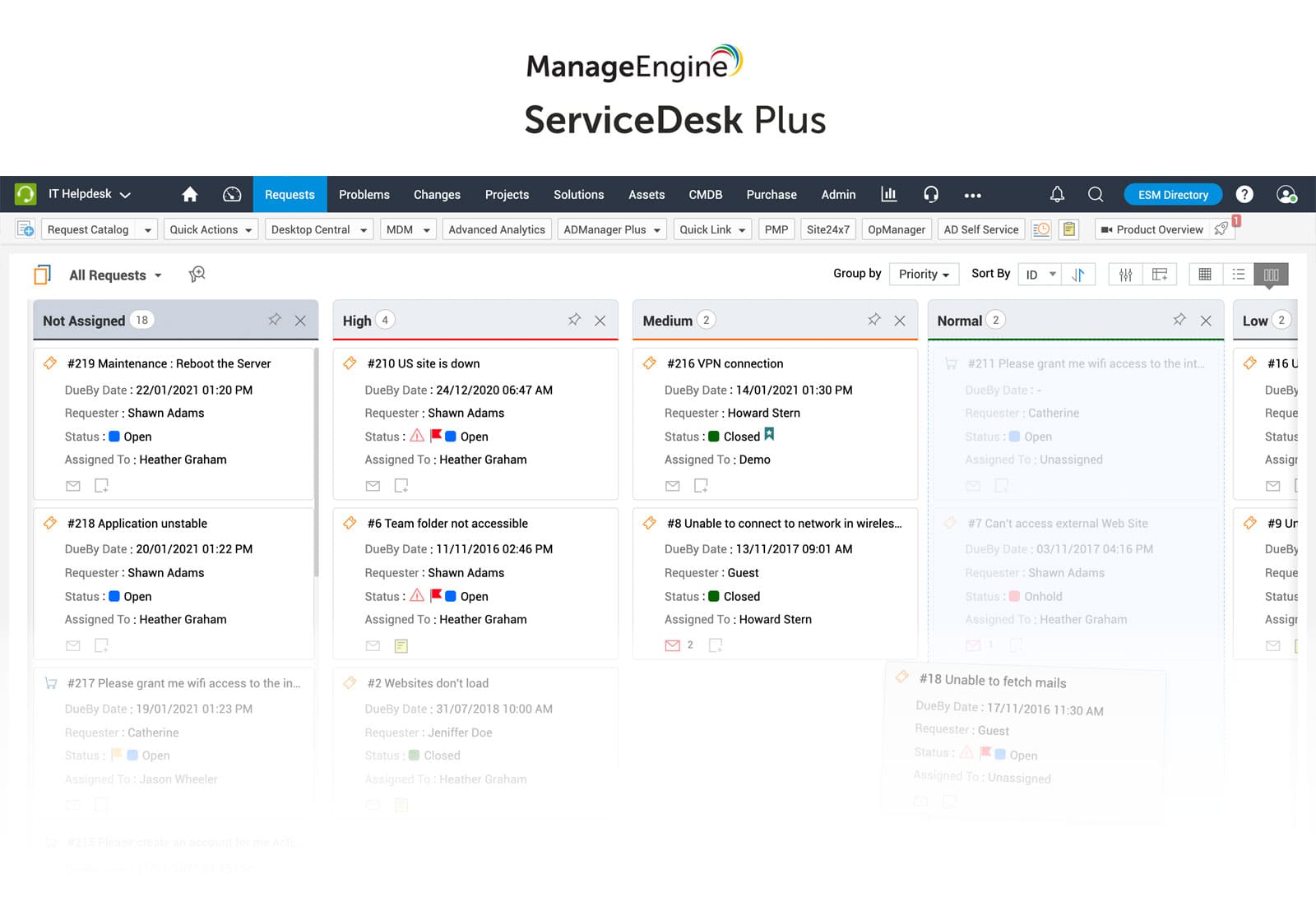
ManageEngine specializes in delivering comprehensive IT Management solutions suitable for businesses of various sizes, primarily focusing on small to midsize enterprises.
Established in 1996 under the name AdventNet Inc., ManageEngine underwent a rebranding in 2009 and is currently recognized as Zoho Corporation. With its headquarters located in Pleasanton, California, ManageEngine has a significant global presence, catering to over 180,000 customers across the world.
Among its offerings is ServiceDesk Plus, a versatile platform that offers both cloud-based and on-premise deployment options. This platform encompasses a wide range of features, including IT Service Management and IT Asset Management. Notably, ManageEngine is classified as a Challenger in the Magic Quadrant.
What users like from ManageEngine
ManageEngine has received rave customer feedback, as confirmed by reviews from sources such as Gartner. Let's take a look at some of the notable benefits highlighted by these customers.
- Varied product portfolio - ManageEngine provides an extensive array of complementary products, encompassing endpoint management, network monitoring, application monitoring, and active directory management solutions. Moreover, by harnessing the low-code development capabilities and line-of-business integrations offered by its parent company, Zoho, ManageEngine can deliver a wide range of platform capabilities and explore opportunities for cross-selling.
- Impressive growth - The platform showcases robust growth potential, evident in its flexible deployment options and successful midmarket segment positioning. In 2021, the company achieved noteworthy revenue expansion and extended its customer base, particularly excelling in the enterprise sector.
- Competitive pricing - ManageEngine distinguishes itself with its remarkably cost-effective IT Service Management (ITSM) offerings. It offers multiple pricing tiers that cater to various budget constraints. This cost-efficiency is particularly appealing to midmarket clients and larger organizations in search of value-driven solutions.
What users don’t like from ManageEngine
Despite its many strengths and positive attributes, ManageEngine has also faced criticism and customer dissatisfaction in certain areas, as reported by sources such as Gartner. Below are some customer concern areas based on an analysis of these sources.
- Limited integrations beyond the Zoho ecosystem - ManageEngine's platform demonstrates its greatest integrative strength when combined with other products within the ManageEngine and Zoho ecosystems. This might pose difficulties for customers seeking seamless integration with popular IT Operations Management (ITOM) tools outside the Zoho ecosystem. In such cases, customers may need to invest additional effort in developing custom API connections.
- Limited product innovation - ManageEngine's primary focus lies in improving processes, facilitating integrations, and offering customization support rather than pioneering groundbreaking product innovations. Although the company has introduced some AI/ML capabilities, such as field and template recommendations, it still lags behind more advanced products in this category.
- Security vulnerabilities - In 2023, ManageEngine encountered a significant setback when two critical vulnerabilities were discovered across 24 of its products. These vulnerabilities received a severity rating of 9.8 out of 10 due to their potential to allow remote execution of malicious code. However, the company promptly addressed the situation by releasing patches to mitigate the vulnerabilities and reinforced its security measures in response to these incidents.
- Unclear ITSM differentiation in marketing - ManageEngine's marketing strategies often fall short of highlighting its unique value proposition within the IT Service Management market. Instead of emphasizing what sets it apart, the company predominantly promotes common themes like low-code development, customer privacy, and deployment flexibility. This approach makes it challenging for ManageEngine to distinguish itself from more seasoned buyers in the market.
What’s ManageEngine’s argument over SymphonyAI Summit Service Management?
ManageEngine presents a compelling argument compared to SymphonyAI Summit Service Management, emphasizing several key advantages that set it apart for businesses seeking robust IT Service Management solutions.
- Comprehensive product portfolio - ManageEngine's product portfolio extends beyond Service Management, encompassing a wide range of IT management solutions. This complete suite of offerings allows organizations to address multiple aspects of their IT infrastructure with integrated solutions.
- Global presence and customer base - ManageEngine has established a significant global presence, serving over 180,000 customers worldwide. This extensive customer base reflects its ability to cater to diverse industry sectors and geographies.
- Affordable pricing - ManageEngine is known for its competitive pricing structure, offering various pricing tiers tailored to accommodate different budgetary requirements. This affordability makes it an attractive option for mid-sized enterprises and larger organizations seeking cost-effective solutions.
Considering InvGate Service Management as an ITSM solution alternative

While SymphonyAI Summit Service Management and ManageEngine are direct competitors in the ITSM sector, it's essential to consider alternative solutions that align more closely with your organization's specific needs. In this context, InvGate Service Management is a compelling option that warrants thorough evaluation.
Let's explore the advantageous features of InvGate Service Management that position it as a valuable choice for meeting your ITSM requirements.
Exceptional user experience
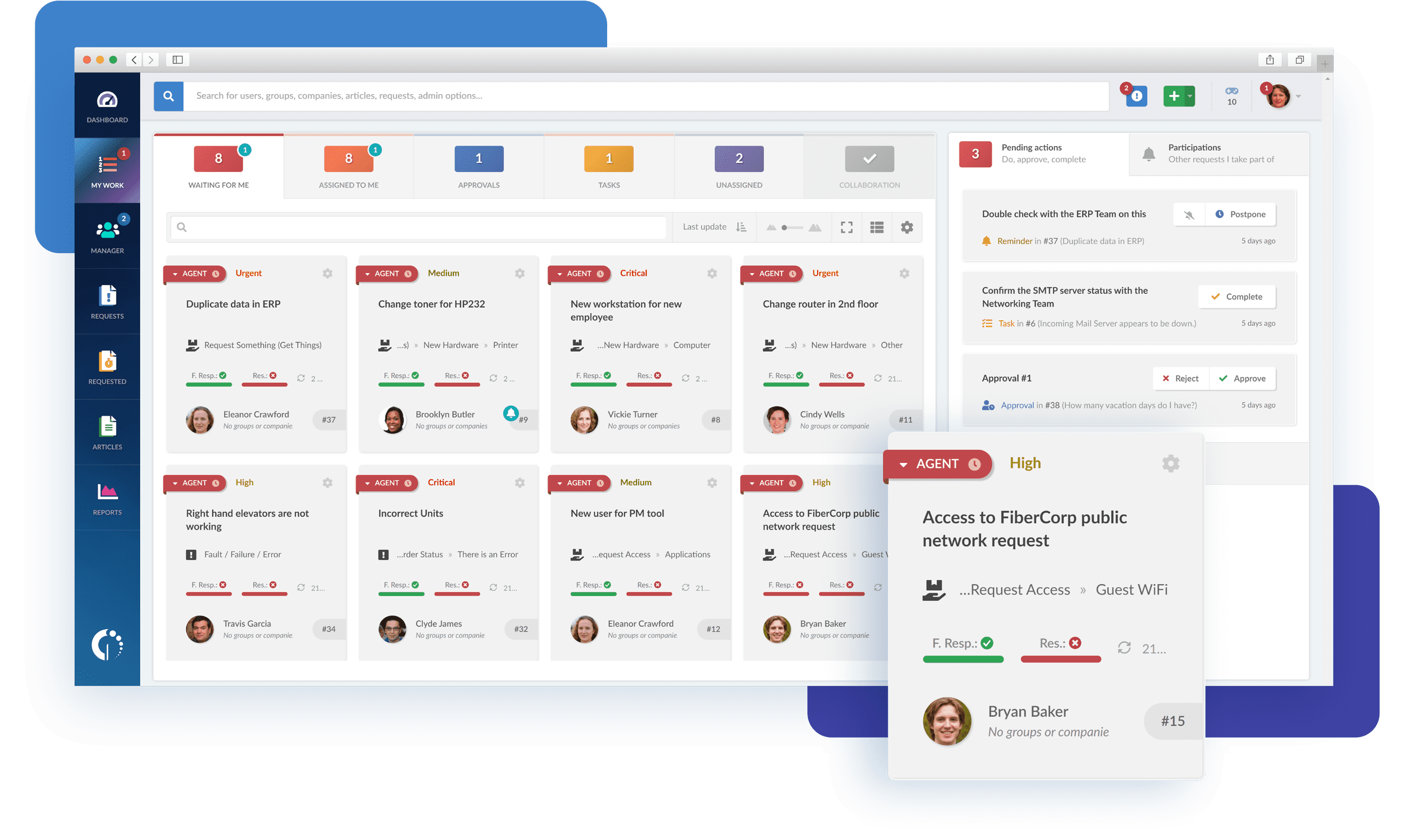
InvGate Service Management strongly emphasizes delivering an outstanding user experience through meticulous design and adherence to UI/UX best practices. Its intuitive interface promotes rapid adoption, reducing the need for extensive training and enabling users to be productive.
Robust Ticketing and Incident Management
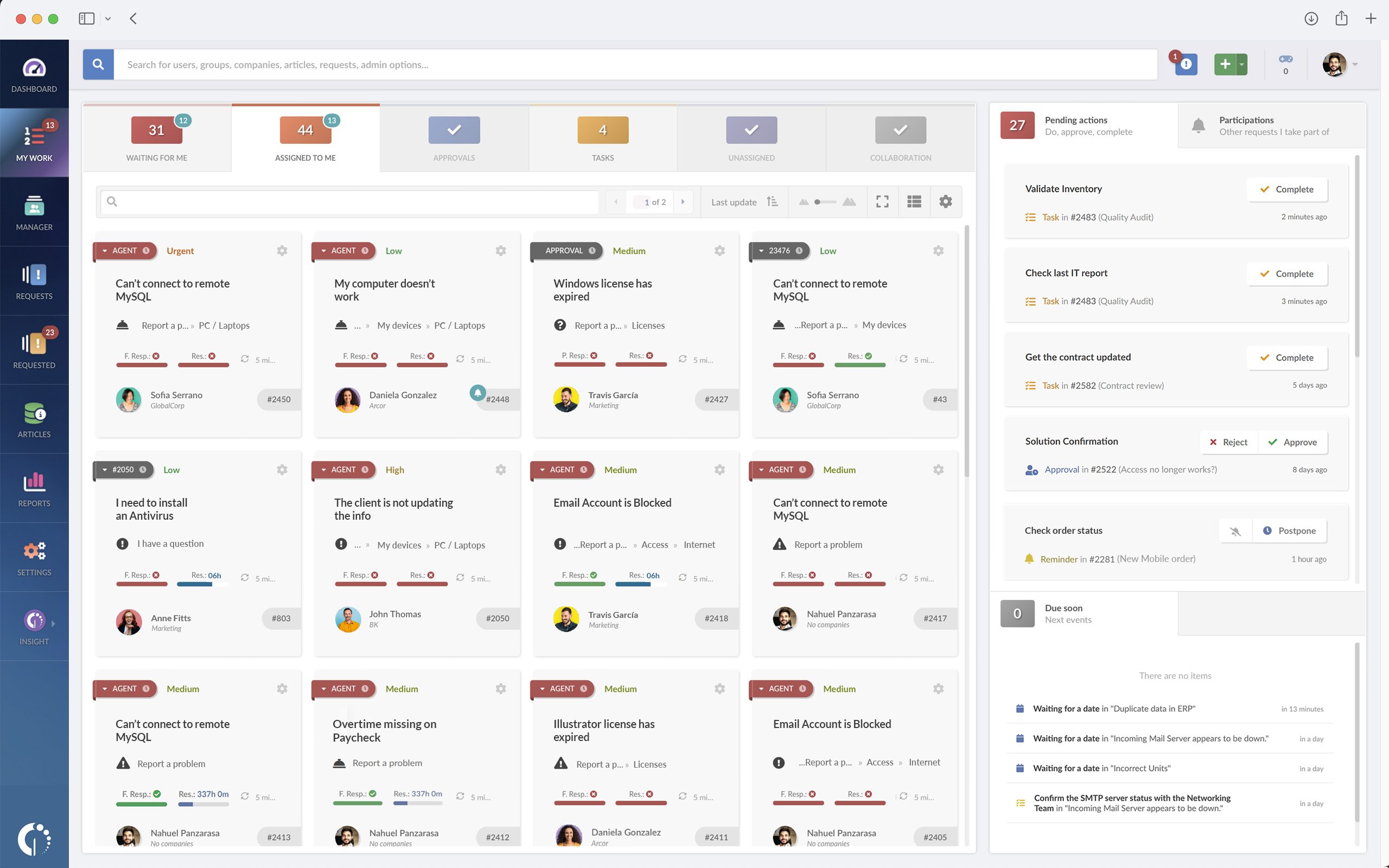
InvGate Service Management distinguishes itself by offering robust Ticketing and Incident Management capabilities. It simplifies ticket tracking, collaboration, and resolution, enabling IT teams to handle and prioritize incidents efficiently. Features like automated ticket routing, customizable workflows, and SLA Management significantly enhance incident resolution efficiency.
Powerful self-service capabilities
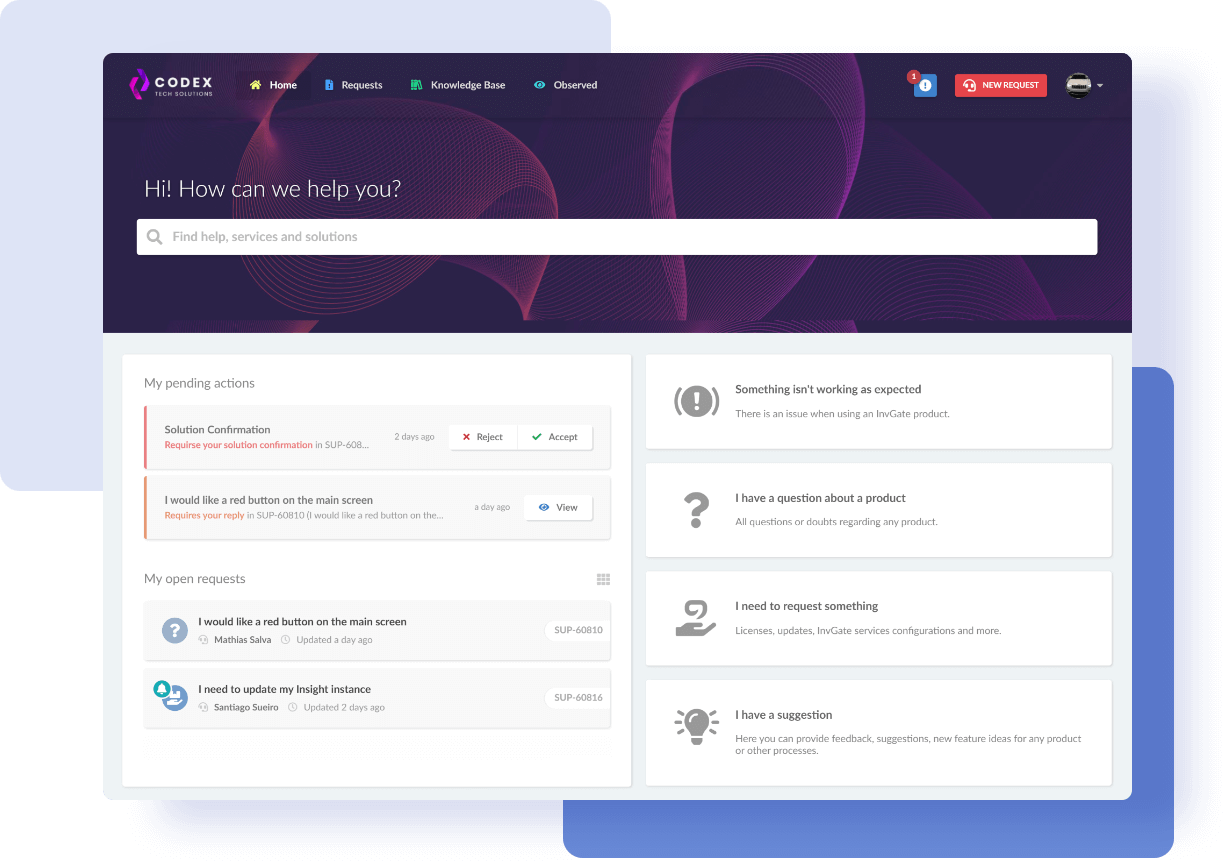
InvGate Service Management incorporates robust self-service functionalities, including an intuitive portal, a comprehensive IT service catalog, and a knowledge base. These features empower end-users to independently resolve common issues, access a wide range of IT services, and utilize self-help resources, thus reducing the workload on IT staff.
Simplified configuration and setup
InvGate Service Management offers a straightforward configuration and setup process, utilizing a no-code/low-code approach. This approach allows novices and experienced users to implement the system without requiring extensive technical expertise. The platform expedites setup by providing easy-to-use configuration options, enabling organizations to harness its robust ITSM capabilities quickly.
Comprehensive reporting and analytics
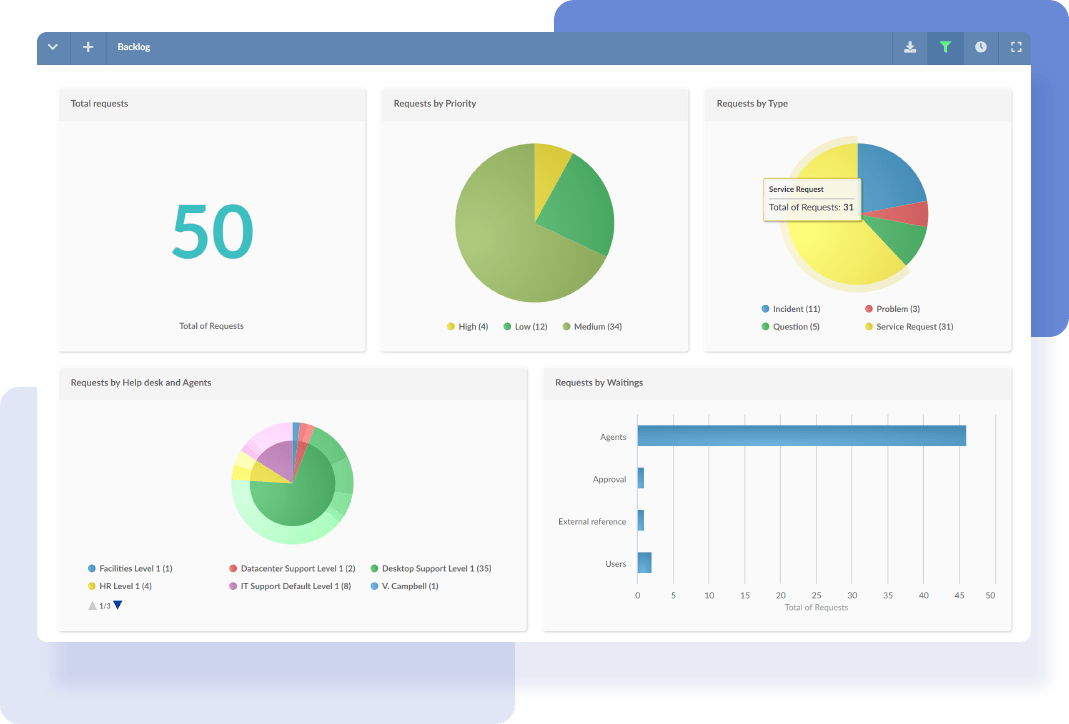
InvGate Service Management provides extensive reporting and analytics capabilities, allowing organizations to gain valuable insights into their IT operations and performance. The platform offers pre-built reports and customizable dashboards, enabling IT teams to analyze data, identify trends, and make informed decisions to enhance their services.
Customization and flexibility
InvGate Service Management provides flexible deployment options, giving organizations a choice between on-premise or cloud-based solutions. This flexibility ensures that the platform can adapt to the specific requirements of various sectors and industries.
Comprehensive Asset Management
Through integration with InvGate Asset Management, organizations gain a comprehensive view of their IT ecosystem, leading to improved service delivery and reduced downtime. InvGate Asset Management offers various features, including IT Asset Discovery, Inventory Management, Software License Management, and maintenance schedules.
Purpose-built for ITSM, ideal for ESM
InvGate Service Management is purpose-designed for ITSM while seamlessly extending its capabilities to Enterprise Service Management (ESM). It empowers operational departments to enhance their processes and fully embrace the benefits of digital transformation. With a primary focus on ITSM and strong performance in ESM, InvGate Service Management facilitates streamlined workflows and comprehensive digital transformation initiatives across all departments.
Cost-effective solution
InvGate Service Management offers a cost-effective solution without compromising on functionality. It provides a comprehensive range of ITSM features at a competitive price point, making it an appealing choice for organizations seeking affordability without sacrificing capabilities. Compared to alternatives like SymphonyAI Summit Service Management and ManageEngine, InvGate Service Management balances cost and functionality.
ITIL-certified readiness
InvGate Service Management has earned ITIL4 certification from PINK Elephant, underscoring its commitment to upholding ITSM excellence. Whether organizations are embarking on their ITIL journey or managing complex operations, InvGate Service Management provides a user-friendly and feature-rich experience aligned with industry best practices.
Fast ROI and ongoing innovation
InvGate Service Management ensures a rapid return on investment through efficient implementation processes. Within weeks, organizations can begin realizing the benefits of this robust ITSM solution. Additionally, regular feature updates keep users at the forefront of technology without incurring additional costs.
Next steps
Choosing the right IT Service Management solution can be a decision of significant consequence, one that can greatly impact your organization's IT service delivery and overall success. As we've examined SymphonyAI Summit Service Management vs. ManageEngine, each platform has its strengths and weaknesses.
A third alternative is InvGate Service Management, which offers a user-centric approach, automation capabilities, and flexibility for customization, making it a strong contender for organizations aiming to optimize their IT service operations.
Explore our live demo and see how InvGate Service Management can transform your IT Service Management.
















